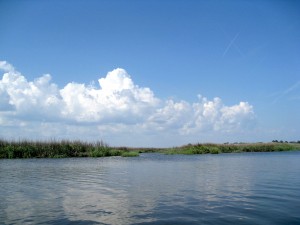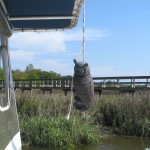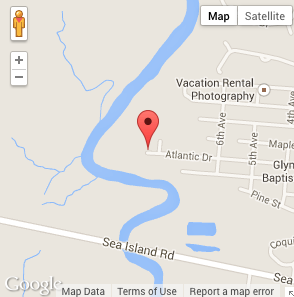 I probably should not have taken the water. Blame scholarly curiosity. In 1803 a group of enslaved Africans jumped shipped here, at Igbo Landing, a tidal estuary off Dunbar Creek on St. Simons Island in Georgia. Written records conclude the slaves committed mass suicide by drowning. Oral traditions say the water connected them to their ancestors, giving the captives power to return home. In early versions the Eboes walk back across the ocean; in recent tellings, they fly. West African beliefs, moreover, hold that after death one’s soul passes on, while the spirit remains with a place.
I probably should not have taken the water. Blame scholarly curiosity. In 1803 a group of enslaved Africans jumped shipped here, at Igbo Landing, a tidal estuary off Dunbar Creek on St. Simons Island in Georgia. Written records conclude the slaves committed mass suicide by drowning. Oral traditions say the water connected them to their ancestors, giving the captives power to return home. In early versions the Eboes walk back across the ocean; in recent tellings, they fly. West African beliefs, moreover, hold that after death one’s soul passes on, while the spirit remains with a place.
At Igbo Landing (spellings vary, the place is now a gated community called Atlantic Pointe) I filled up a plastic bottle from the brackish low tide. I took the bottle home as a souvenir. The water sat on my desk through my sabbatical year, while I drafted my current book in progress, A Road Course in American Literature. I talked to the spirits. I gave them tobacco. I diligently drafted each of the book’s twelve chapters. (I fulfilled my sabbatical promise.) Algae bloomed in the bottle, and last Spring, I returned the spirits. I thanked them, apologized and promised that the Road Course would honor their memory.
 But I was wrong about Igbo Landing. According to a know-it-all historian, Ebo Landing is not where people place it. The plastic bottle held just water — nothing else. Besides, there was a healing ceremony ten years earlier. Any restless spirits in Dunbar Creek, an island native assured me, have been laid to rest.
But I was wrong about Igbo Landing. According to a know-it-all historian, Ebo Landing is not where people place it. The plastic bottle held just water — nothing else. Besides, there was a healing ceremony ten years earlier. Any restless spirits in Dunbar Creek, an island native assured me, have been laid to rest.
But the story of the Flying African keeps me coming back. According to one version, while flying home, the captives broke into the civil rights anthem “Oh Freedom.” Troubled landscapes have a way of carrying us back into the past. History does not go away here.
As I revise the Road Course for book form, starting in May 2014, I will post excerpts. Please visit regularly. Click the map, go to the blog, or check out the videos, lists and links. Join me on this journey, as I explain the continued relevance of a course from the perspective of a teacher-scholar, unrepentant tourist, father, friend and son.

